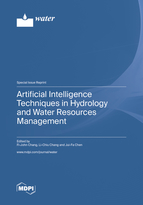Artificial Intelligence Techniques in Hydrology and Water Resources Management
A special issue of Water (ISSN 2073-4441). This special issue belongs to the section "Hydrology".
Deadline for manuscript submissions: closed (31 October 2022) | Viewed by 52293
Special Issue Editors
Interests: hydrological forecasting; AI techniques; data-driven modelling; water resources management; system analysis; optimization
Special Issues, Collections and Topics in MDPI journals
Interests: artificial neural networks; genetic algorithms; data mining; flood forecasting; hydrosystems; reservoir operation; urban hydrology
Special Issues, Collections and Topics in MDPI journals
Special Issue Information
Dear Colleagues,
Artificial intelligence (AI) techniques (e.g., machine learning, deep learning, artificial neural networks, evolution algorithms, and so on) have shown great potential in hydrology as well as water resource management. In addition, new datasets with high spatial and temporal resolutions are emerging at an unprecedented rate, which has opened up new avenues in hydrological science. Future transformative impacts may be realized through AI to improve linkages between big data, prediction, and decision making. We seek to gather the latest developments in AI techniques to collate the knowledge about various hydrological processes, improve their prediction, and promote water resource management. Submissions of theoretical studies and state-of-the-art AI practical applications are welcome. Potential topics of interest include, but are not limited to:
- Reviewing AI techniques in hydrology and/or water resources management;
- Introducing new AI techniques that account for the spatial and temporal structure of hydrological data;
- Hydrological process forecasting (e.g., flood, drought, groundwater, evapotranspilation, water temperature, water quality, etc.);
- Solving problems of watershed hydrology, considering either the quantity or quality or both aspects of water;
- Improving water and environmental systems;
- Promoting urban water–energy–food nexus synergies;
- Nowcasting hydrologic time series;
- Modelling flood inundation and risks;
- Reducing computational resources required for field-scale simulations;
- Quantifying uncertainty of hydrological modelling and water quality modelling;
Prof. Dr. Fi-John Chang
Prof. Dr. Li-Chiu Chang
Dr. Jui-Fa Chen
Guest Editors
Manuscript Submission Information
Manuscripts should be submitted online at www.mdpi.com by registering and logging in to this website. Once you are registered, click here to go to the submission form. Manuscripts can be submitted until the deadline. All submissions that pass pre-check are peer-reviewed. Accepted papers will be published continuously in the journal (as soon as accepted) and will be listed together on the special issue website. Research articles, review articles as well as short communications are invited. For planned papers, a title and short abstract (about 100 words) can be sent to the Editorial Office for announcement on this website.
Submitted manuscripts should not have been published previously, nor be under consideration for publication elsewhere (except conference proceedings papers). All manuscripts are thoroughly refereed through a single-blind peer-review process. A guide for authors and other relevant information for submission of manuscripts is available on the Instructions for Authors page. Water is an international peer-reviewed open access semimonthly journal published by MDPI.
Please visit the Instructions for Authors page before submitting a manuscript. The Article Processing Charge (APC) for publication in this open access journal is 2600 CHF (Swiss Francs). Submitted papers should be well formatted and use good English. Authors may use MDPI's English editing service prior to publication or during author revisions.
Keywords
- artificial intelligence
- machine learning
- evolution algorithms
- deep learning
- hydrological processes
- water resources management
- time series modelling
- groundwater
- water quality
- forecasting








